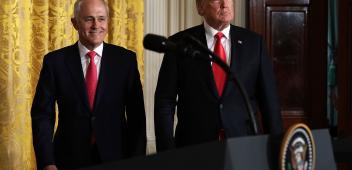A super-profits tax on resources could repair budget
Originally published in The Australian.

Whatever the justification for fistfuls of election-related dollars, in the medium term the budget deficit has to be reined in. But this need has brought forth the same shop-soiled prescriptions.
Free-market, small-government proponents see the answer in cutting outlays. In the face of implacable demands on the budget, this is pie-in-the-sky. We’re not going back from the current expenditure/GDP ratio of 27 per cent, to the pre-pandemic 24.5 per cent. The same voices support the proposed increase in defence expenditure, with its inevitable cost overruns. They may not support the burgeoning increases in expenditure on aged care, disability, childcare, infrastructure, healthcare and climate change, but these increases will continue, like it or not. Without the discipline of the bottom line, governments tend to be profligate. Certainly, we should demand expenditure discipline and oppose electoral sweeteners in marginal electorates, pork-barrel dams and make-work programs. But governments will inevitably be responsible for a larger share of GDP over time.
Thus we need to focus on the revenue side. The usual suspects have been rounded up: increase the GST and widen the coverage; abolish negative gearing; cut the superannuation perks for the wealthy; increase capital gains tax; tighten up on means testing; and impose a land tax.
These sensible ideas have been considered in the past and rejected, usually on political grounds: “We know what to do, but we don’t know how to get re-elected after we do it.”
Let’s revive an almost-forgotten option: a super-profits tax on resources. Last time this appeared, it was strangled at birth by the mighty public relations machine of the resources lobby. But since then, we have had time to digest the stunning structural shift in the Australian economy over the past 15 years – a shift which is all about resources.
Here are the facts. Since the early 2000s, our commodity prices have trebled, our terms of trade have doubled and resources have gone from around 45 per cent of exports to a dominant 70 per cent now.
The case for a super-profits tax is two-fold. First, macro-management – how to ameliorate the boom-bust economic cycle caused by volatile commodity prices? Second, fairness – who should pay for deficit repair and government’s bigger role?
First, the macro-management case. For better or worse, we are now a resource-based economy, subject to huge swings in global commodity prices. Our exchange rate reflects this, with tendency towards the classic Dutch Disease symptoms – the resources bonanza pushes up the exchange rate at the expense of manufacturing and the non-resource export sectors. The Aussie dollar has been held down only by keeping the interest rate artificially low for 10 years, at the cost of serious asset inflation, especially in housing.
If instead of spending the cyclical windfalls, we banked them in a foreign-currency sovereign fund, to smooth the fluctuations in the commodities-driven Aussie dollar and iron out expenditures over the business cycle, this would smooth the growth path of the economy. This would also discipline the tendency of the budget to be over-generous in good times, as demonstrated by the tax-cutting largesse in the early years of the resources boom.
There is a longer-term aspect as well. Over 20 per cent of our resource earnings come from coal. A realistic forecast of the next 30 years would show a dramatically smaller role for coal exports. In the short term, this may be balanced by an increase in LNG exports, but a declining role for both seems likely in the longer term. We should salt away a portion of our current revenue from these commodities, in the same way that Norway has been building up a sovereign fund to soften the impact of resource depletion.
What has this structural change done for fairness? In this 15-year period, business has done well (profits are historically high). Resources have had a bonanza. Meanwhile, labour has been squeezed by chronically low wage increases, further eroded more recently by accelerating inflation.
That’s the economic case. But is it politically feasible? What forces will oppose it? Looking back, it’s hard to believe that an industry lobby group, largely representing foreign shareholders, was so successful in sinking the Rudd proposal. One of the lessons of this episode is that Treasury has to design a tax that is simple enough to be understandable, and hence defensible. Introducing it at a time when commodity prices are weak (and thus the super-tax low or zero) would be sensible.
Would the big miners go elsewhere? Australia’s richest person warns of low-cost foreign competition. The then-Rio boss told us in 2010 that Australia was his greatest sovereign risk. Since then, Rio has had a long-running drama with the Simandou iron ore deposit in Guinea. It has paid several times for its stake in Mongolia’s Oyu Tolgoi copper mine. It all looks like very hard pounding.
Easier to operate in a democracy, where you can take your case to the public, if it is defensible to public scrutiny. If the big miners don’t want to take up all the opportunities to invest in resources, someone else will, as Forrest has demonstrated.
Of course a super-profits tax won’t be nearly enough to solve Australia’s revenue shortfalls. Rudd’s proposal was forecast to raise just $22bn over four years. But the default fallback is bracket creep – insidious and, like the GST, regressive. Like plucking a goose, the squawking should be minimised by distributing the burden among all those with some capacity to pay. With break-even around $US30 per tonne for the big iron ore producers, and current price around $US140 per tonne, there is clear capacity.



